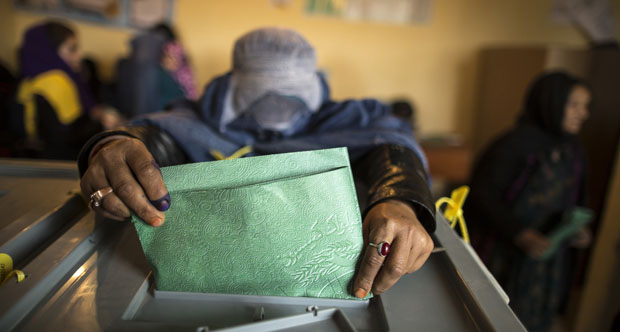 Following Afghanistan’s presidential election Saturday, ballots from villages of the Hindu Kush mountains are wobbling down dirt paths toward counting centers, lashed to the backs of donkeys. While we will need some weeks to know the official outcome, in which the top two candidates are likely to face a runoff, we know some key effective results of this election:
Following Afghanistan’s presidential election Saturday, ballots from villages of the Hindu Kush mountains are wobbling down dirt paths toward counting centers, lashed to the backs of donkeys. While we will need some weeks to know the official outcome, in which the top two candidates are likely to face a runoff, we know some key effective results of this election:
|
1. Afghans have not given up on democracy. In this, the Afghans’ third popular election for a president, about 7 million people voted (roughly 58 percent of those eligible), according to the first numbers from the national election commission. That participation is a rebound toward the hopeful optimism of Afghanistan’s first presidential vote, which elected Hamid Karzai in 2004. About 8 million people (70 percent of those eligible) cast ballots then, but participation sagged to roughly 4.5 million, (30 percent) in 2009. In that year, Karzai’s re-election was so fraud-tainted that it was not clear that Afghans had a real choice.
With Karzai having served the constitutional limit of two terms, they have a choice this time, so voters came back. It seems a miracle that Afghans retain real hopes for a state system that has failed to provide security, that has practically stopped offering new economic opportunity, and that assaults them with corruption. But Afghans really have no alternative systems. Those of their modern history – tribal rule under weak monarchies and the 1970s-80s attempts at a centralized, single-party state – are dead. The remaining option, the Taliban, are of course fighting for a comeback with help from allies in neighboring Pakistan. The Taliban were the big losers Saturday when such a strong majority of eligible Afghans ignored their murderous attacks and threats to stand in long lines to vote.
2. Afghan women are in politics to stay. After a century in which the West as often harmed as helped Afghanistan’s feminist movements, the past twelve years have created a space for women in politics that will not easily be erased, at least in Kabul and the other cities that contain Afghanistan’s strongholds of liberal, modernizing ideas. In the first popular presidential election, in 2004, Massouda Jalal ran as a show-the-flag candidate, and was followed by symbolic women’s candidacies in 2009.
A decade after that first vote, urban women are visible and independent enough to force candidates to pay them greater attention than Karzai has done. Three presidential candidates took women as vice-presidential candidates, and one of those – the dynamic former Bamiyan provincial governor Habiba Sarabi – has generated at least as much interest as her running mate. And 300 women, an increase from the two prior elections, ran for the provincial councils also chosen Saturday. It will take years (indeed generations) for Afghan women to move broadly from token roles to real political leadership, but this election advances that process.
Most Afghan women hold a real status somewhere between property and wards of their male relatives. And a conservative backlash against public roles for women remains powerful. It will expand as the next government seeks a negotiated settlement with the Taliban. But Afghans’ education and awareness of the outside world is the women’s ally, and will not be rolled back in the cities.
3. Afghanistan will continue to modernize amid violence and corruption, city vs. countryside. Afghanistan always has modernized from Kabul, Mazar-i-Sharif, Herat and other cities. Saturday’s heavy urban voting (against the light turnout in rural zones dominated by the Taliban) reinforces that pattern. The portion of Afghans living in cities has risen from 10-14 percent in the 1970s, before the Soviet occupation, to about 25 percent today.
Modernization of course does not assure good governance or liberal values. While warlord candidates from among the anti-Soviet mujaheddin guerrilla movements did not lead polling in this race, they were prominent as minor candidates and running mates, and are reminders that corruption and tribalized politics will remain powerful no matter who replaces Karzai.
Modern statehood and liberal ideas have advanced haltingly in Afghanistan amid violence and even civil war, ever since the reign of King Amanullah and Queen Soraya (the country’s first prominent women’s rights advocate). The royal couple led reforms in the 1920s only to be overthrown by rural tribes. Britain aided that conservative backlash because a strong Afghan state was a potential threat to northwestern British India (now Pakistan). Nearly a century later, conservative Pakistani nationalists and Islamists back the Taliban’s war against Afghan democracy for much the same reason. That interference will not end until the two countries settle deep, murky border disputes and Pakistan moves from military-dominated to more transparent governance.
4. The Taliban will never come back to rule as they once did. Saturday’s vote for a democratic future underscores Afghans’ broad rejection of the Taliban option. And even if the current crop of Taliban could somehow march into power in Kabul, they could not impose quite the obscurantist regime that their movement ran in the 1990s. At the same time, the US-backed Afghan state cannot defeat the Taliban militarily with their Pakistani backing. Whatever compromise future emerges, the isolation of Afghanistan, enforced for generations by geography and in the 1990s by the Taliban, cannot be re-imposed.
James Rupert is managing editor at the Atlantic Council.
Image: An Afghan woman casts her ballot at a polling station in Mazar-i- sharif April 5, 2014. REUTERS/Zohra Bensemra
